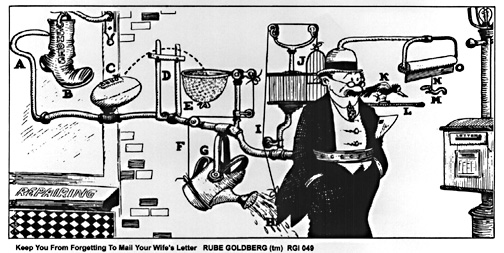Challenge Statement
Create a mechanical system inspired by Rube Goldberg to move a golf ball over a certain height and to a designated location through a large number of energy transfers.
Lab Goals
- Combine different backgrounds to complete a common task.
- Create a reliable machine with reproducable results.
- Implement devices exploited in mechanical automation and appreciate electrical technology.
- Gain experience using the resources in the REL and throughout campus on a tight time constraint.
Background
History
Technology has allowed for the simplification of tasks since the Stone Age. Ancient civilisations improved efficiency through simple machines, water and steam power[1].
The Industrial Revolution (late 1700s through 1800s) brought about further technologies that enabled increased specialization and distribution of products throughout civilizations[2].
Beginning in the mid 20th century, computers began to arise and shape the course of innovation [3]. Around this time, electricity also became common throughout American cities, paving the way for the future of automation [4].
Rube Goldberg Machines
Rube Goldberg was born in 1883[5]. He is best known for his cartoons depicting overly-complex contraptions that achieve some simple result. The image below shows an example of this:
 |
|
Example Process to "Prevent You From Forgetting To Mail Your Wife's Letter": As you walk past cobbler shop, hook (A) strikes suspended boot (B), causing it to kick football (C) through goal posts (D). Football drops into basket (E) and string (F) tilts sprinkling can (G), causing water to soak coat tails (H). As coat shrinks, cord (I) opens door (J) of cage, allowing bird (K) to walk out on perch (L) and grab worm (M), which is attached to string (N). This pulls down window shade (O), on which is written, "YOU SAP, MAIL THAT LETTER."
|
Principles
You may have to combat the following while developing your machines:
- Potential and Kinetic Energy: Energy is always conservedin a process, which can be desribed with the following equation: PE(t=0)+KE(t=0)=PE(t=tf)+KE(t=tf)+W(done by system). Where PE is potential energy and is most commonly in the form of gravitational potential energy (mgh, where m is mass, g is the acceleration of gravity and h is height) or elastic potential energy (0.5kx^2, where k is the spring constant and x is the displacement of the spring from rest length). And KE is kinetic energy (0.5mv^2 were m is mass and v is velocity). W represents work, which can be cause by an object moving despite friction or heat absorbed by the system. In the simple case of friction, work equates to force times distance in the case of motion.
- Friction: Friction can be an aggravating phenomenon for engineers. Two objects in contact will experience a force due to static friction when they are not in motion (normal force times a static coefficient) and a force due to kinetic friction (normal force times a kinetic coefficient of friction). As CMU Physics professor, Dr. Briere will say, the force of friction will always oppse the relative motion that would occure if the friction were not there. Coefficients of friction can be looked up from previous experimental results (this is a good resource: Engineering Toolbox) and it is worth noting that the coefficient of kinetic friction is typically lower than the coefficient of static friction (which is why it may be difficult to budge an object like a refrigerator, but it is slightly easier to continue to move it onece it is already moving).
- Momentum: Momentum (p) can be described as mass (m) times velocity (v). This principle will come into play with processes including successive bumping to trigger motion. The object striking a successive process must either have a larger mass or be moving fast enough to be able to affect the next mass.
Lab Requirements
The Specifications for Lab 1 are presented in the following document. This will be the most up-to-date resource for lab requirements.
2018 Lab 1 Presentation
2018 Lab 1 Grading Sheet
2018 Lab 1 Demonstration Sign Up Sheet
Extensions
Examples of Rube Goldberg Machines
Previous 16-311 Demo: Golf Ball Transfer
Previous 16-311 Demo: Cracking an egg
Previous 16-311 Demo: Pouring a can of soda with a mouse
Previous 16-311 Demo: Pouring soda with Dominoes
Famous Honda 'Cog' Commercial
Rube Goldberg Competition
OK Go Rube Goldberg Machine Music Video
|
 16-311 Introduction to Robotics
16-311 Introduction to Robotics 16-311 Introduction to Robotics
16-311 Introduction to Robotics